April 2019:
Me and 4 friends pulled a 1,000 pound glass aquarium out of a wall and placed it on a trailer to be returned to the manufacturer. This 96″ x 36″ x 37″ (550 gallon) freshwater system had cracked on one end, top to bottom, because of an unfortunate event.
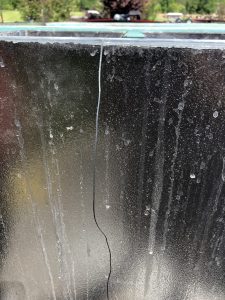
Healthy crack in 3/4″ glass.
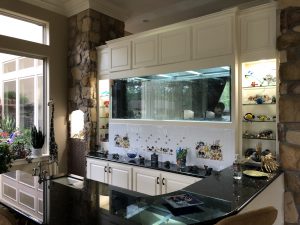
The 550 gallon, emptied, bar side.
This system sits in a wall that divides the foyer from the home’s bar. It is viewable on the two long sides and has an overflow box on each of the two short sides. Each overflow has three 1″ bulkheads; two drains and one return. An 800 watt titanium heater sat inside an overflow box which was controlled by a Ranco digital temperature controller. The temperature controller’s probe sat just outside of the overflow box, taking readings from inside the tank itself. I was performing a water change one cold day in December and the water coming back into the aquarium triggered the Ranco to turn the heater on while I had the water level about a foot down from the overflow teeth. I had the main pump turned off so water was not splashing down into the overflow box, taking the heated water with it down into the sump. Basically the heater was over heating the water in the overflow box. I was going about my business, gravel vacuuming the tank, when I heard a deep pop. It confused me because I couldn’t tell if the sound had something to do with the aquarium or not. There was no water rushing onto the floor or anywhere else. What had happened was, between the very hot water stuck in the overflow box and the cold water in the aquarium, the 3/4″ thick glass cracked…right down the middle of where the overflow box covered. Very lucky in that regard but a very unfortunate event. I drained the aquarium that night, took all the fish out and spread them between my house and a couple other clients’ systems. A rough day indeed.
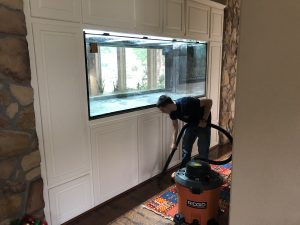
Alex cleaning up after we prepped the system a couple days beforehand by removing the trim and all decorations inside the tank.
Now that the explanation for why it had to come out is out of the way, let’s get to what this post is really about; how to successfully pull a large aquarium out of a wall and put it on a trailer without hurting anything or anyone.
There are many details to consider in this situation. Hiring quality people, protecting the client’s home, using your brain more than your muscles. It’s not so hard if you cover all your bases and really put your mind to it. Years of experience obviously make the difference but that is why I want to share that with you here.
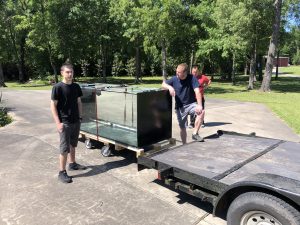
Alex, Zach and Laurent pondering how we are going to get this beast onto the trailer from this position.
First off, either the system has live fish and decorations in it or it is empty. Preferably you have emptied the system of all contents because moving something this big while concurrently dealing with a bunch of livestock is terribly stressful and not in the scope of this post.
My helpers this day were Alex, Laurent, Curtis, and last but not least, Zach. Five guys in total, including myself. Doesn’t seem like enough for a 550 gallon system? In fact, we could have done it with four if we had to. The trick is to let machines do the work and not rely solely on people power. I’d rather hurt a rented machine than a fellow human.
I’m going to cover this in great detail, so get in, sit down, and put your seat belt on. Let’s talk about the stuff I used to accomplish the job.
EQUIPMENT
The following is a list of equipment I used for this job. Some of it was rented and some custom made by myself and others. These are things I use as a professional and I realize equipment like the glass suction cups and the “furniture dollies on steroids” are somewhat impractical to make or acquire for just a one time move, but they sure make life easier.
GENIE SUPER-LIFTS
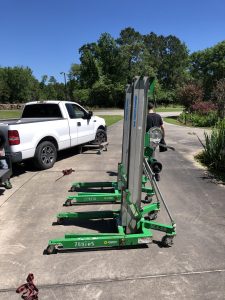 In the U.S. and Canada, there is a heavy equipment rental franchise called Sunbelt Rental. Check them out by clicking HERE. You can rent anything from small hand tools to massive bulldozers. Every time I am tasked with moving an aquarium that is tall and made out of thick glass (heavy), or anything around 300 gallons or more, I rent a Genie Super-lift or two from Sunbelt. I don’t use Super-lifts to maneuver tanks around as they honestly are not very nimble nor agile, but can also scratch the Hell out of a client’s expensive flooring. The casters on them are small and hard and can also mark up floors. What we do use them for is raising or lowering heavy aquariums onto big dollies with large 9″, rubber, non-marking casters. These Genie material handlers are raised or lowered via a hand-crank located on the backside. If you rent one to help you with an aquarium, be sure to specify that you are more concerned with lift capacity and not height capacity. These machines are often used to lift HVAC components high up to a commercial building’s ceiling so some of them have a greater capacity for lifting things higher. You don’t need that capability here, plus that only adds to the unit’s weight and makes it more difficult to move around..
In the U.S. and Canada, there is a heavy equipment rental franchise called Sunbelt Rental. Check them out by clicking HERE. You can rent anything from small hand tools to massive bulldozers. Every time I am tasked with moving an aquarium that is tall and made out of thick glass (heavy), or anything around 300 gallons or more, I rent a Genie Super-lift or two from Sunbelt. I don’t use Super-lifts to maneuver tanks around as they honestly are not very nimble nor agile, but can also scratch the Hell out of a client’s expensive flooring. The casters on them are small and hard and can also mark up floors. What we do use them for is raising or lowering heavy aquariums onto big dollies with large 9″, rubber, non-marking casters. These Genie material handlers are raised or lowered via a hand-crank located on the backside. If you rent one to help you with an aquarium, be sure to specify that you are more concerned with lift capacity and not height capacity. These machines are often used to lift HVAC components high up to a commercial building’s ceiling so some of them have a greater capacity for lifting things higher. You don’t need that capability here, plus that only adds to the unit’s weight and makes it more difficult to move around..
FURNITURE DOLLY ON STEROIDS
For maneuvering heavy aquariums around, I made what I call “furniture dollies on steroids”. The parts list to make them 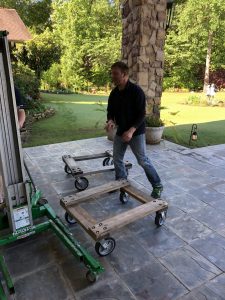 included stainless steel nuts, bolts, and washers, 9″ non-marking casters, and several lengths of 2 x 8 weather-proof boards. I made two of these dollies and they are heavy (about 80 pounds), but they come in extremely handy when moving big aquariums around. In total, they cost me several hundred dollars each to make but they are invaluable if you are doing this often. If you are only doing this one time only and not on the regular, a normal furniture dolly could be OK on smaller systems but not on big tanks like the one shown in this post. The casters will fall apart underneath all that weight and they also wouldn’t traverse obstacles very well. Word of advice: Every time you put an aquarium on a dolly, use a tie-down to hold the aquarium to the dolly. You do not want a dolly slipping and sliding underneath an aquarium while you are trying to maneuver over curbs, bumps, tight turns, and over thresholds.
included stainless steel nuts, bolts, and washers, 9″ non-marking casters, and several lengths of 2 x 8 weather-proof boards. I made two of these dollies and they are heavy (about 80 pounds), but they come in extremely handy when moving big aquariums around. In total, they cost me several hundred dollars each to make but they are invaluable if you are doing this often. If you are only doing this one time only and not on the regular, a normal furniture dolly could be OK on smaller systems but not on big tanks like the one shown in this post. The casters will fall apart underneath all that weight and they also wouldn’t traverse obstacles very well. Word of advice: Every time you put an aquarium on a dolly, use a tie-down to hold the aquarium to the dolly. You do not want a dolly slipping and sliding underneath an aquarium while you are trying to maneuver over curbs, bumps, tight turns, and over thresholds.
GLASS SUCTION CUPS
 Glass suction cups are nice to have in order to yank something out of a wall or to help get a better grip while moving a big tank around on dollies. I don’t feel like they are an absolute necessity, especially if you are just moving one tank, one time only and wouldn’t find any further use for them. With the frequency that I am moving tanks around, they are nice to have for sure. You can find them, as well as everything else in the world, on Amazon.
Glass suction cups are nice to have in order to yank something out of a wall or to help get a better grip while moving a big tank around on dollies. I don’t feel like they are an absolute necessity, especially if you are just moving one tank, one time only and wouldn’t find any further use for them. With the frequency that I am moving tanks around, they are nice to have for sure. You can find them, as well as everything else in the world, on Amazon.
TIE-DOWNS
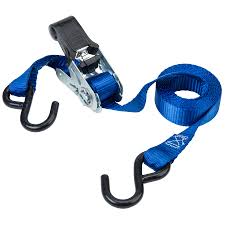 Ratcheting tie-downs are a must in aquarium moving. Besides using them to strap the aquarium to a furniture dolly, you will use them to secure the aquarium during transportation.
Ratcheting tie-downs are a must in aquarium moving. Besides using them to strap the aquarium to a furniture dolly, you will use them to secure the aquarium during transportation.
THE MOVE
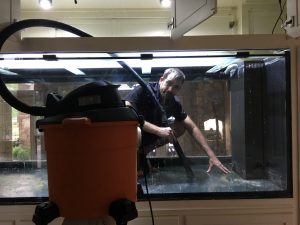
We vacuumed out the gravel from the system a couple days prior and removed the trim from around the aquarium.
One fine Saturday morning, me, Alex and Laurent in my truck met Zach and Curtis in their truck at the local Sunbelt Rental location to pick up two Genie Super-lifts. Their prices had come down a bit and I was happy that a daily rental for both of them was only going to be about $135.00. In the past, it had been closer to $180.00. With a Genie in each truck bed, we headed off to Home Depot before going to the client’s house on Lake Conroe.
At Home Depot we procured several large cardboard boxes to protect the floor from heavy equipment and several 2x4s in order to make a pallet for the tank to sit on for the journey and to make it easier for the manufacturer to remove it with a forklift.
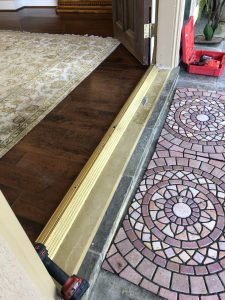
Threshold about to be removed using my trusty Milwaukee cordless drill.
Once we arrived at the client’s place, the first thing to do was to remove the threshold from the doorway. Experience has shown me that they can get crushed under the dolly’s wheels and I didn’t want to have to purchase a new one for the client if I could avoid it.Remember, we want to get this thing out, but not at the expense of the client’s house. Slow and steady wins the race.
With that out of the way, next up was removing the Super-lifts from the trucks. They are pretty heavy and somewhat dangerous to remove by hand so you want to be sure to have plenty of hands on them as far as pulling them out of a truck goes. Four people makes it much safer.
Next, I had Alex use painter’s tape to secure the broken down cardboard boxes to the wood flooring. Painter’s tape is best here because it comes back up without leaving any residue.
We picked up and carried the Super-lifts into place, onto the cardboard. Rolling them across the floor would surely damage the client’s property. When doing this sort of thing professionally, a lot of thinking has to go into protecting the client’s home. Your mind should be on the possible liabilities you could face here. Brains are more important than brawn in a situation like this.
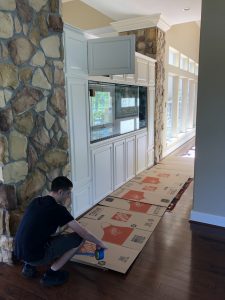
Alex using painter’s tape to secure the cardboard boxes to the client’s floor

We carried the Super-lifts over to the cardboard so as not to scratch the client’s floor. Notice the dolly in between the two lifts.
Before tackling the tank, Curtis, Zach and I brainstormed about building a pallet out of 2x4s to sit under the tank. A pallet would make it safer for us to set the aquarium down onto the trailer and also much easier for the manufacturer to pull it off the trailer with a forklift when we got there. Curtis drew a plan on a piece of paper based on what I described to him, then marked up the 2x4s for cuts. Alex and I made the cuts on a chop saw that I brought and then we screwed them together using the deck screws which we had gotten at Home Depot. Zach put forth the idea that it would be easier to put the pallet on the Super-lift forks and then pull the aquarium onto it rather than trying to set the tank onto the pallet as it sat on the trailer. It was a good call. We used tie-downs to secure the pallet to the lift forks so it wouldn’t shift as we pulled the aquarium onto it. There was only room enough for one of my dollies but upon lowering the tank onto it, we realized that one was all that was needed.
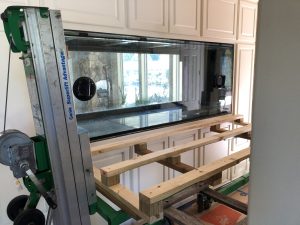
Here you can see the suction cups on the tank and the pallet set across the lift forks.
Pushing/pulling it out of it’s box in the wall wasn’t so bad. A couple days before this move, Alex and I had prepped the aquarium by removing the trim that framed the tank in on the foyer side, removed all the branches and rocks from the tank, cut the plumbing, undid all 6 bulkheads, and vacuumed out all the substrate. Now, on the moving day, with the two Super-lifts in place, a dolly in-between them and the pallet attached to the lift forks with tie-downs, we were ready to remove it. We had three pushing on the bar side while Zach and I pulled on the other side using the suction cups as hand holds. After 10 seconds of trying to push/pull it in unison unsuccessfully, I decided it might make more sense to concentrate on one side at a time. That did the trick. Initially it was difficult to budge but we found that by concentrating all our efforts on one side, then the other, we were able to get it moving. Further movement became easier as we went because less contact, less friction.
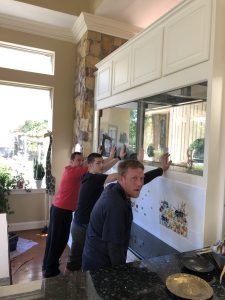
Laurent, Alex, and Curtis pushing from the bar side
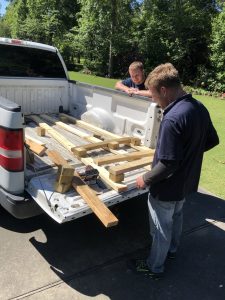
Curtis planning out the pallet for the tank to sit on.
We got the heavy tank pulled onto the dolly held aloft by the two Super-lifts without incident. Zach and I lowered the tank in unison as Curtis kept on eye on it to ensure we were lowering it at a similar rate. When it got down close to the dolly sitting on the floor between the two lifts, Curtis removed the tie-downs holding the pallet to the lift forks and re-positioned them to hold the tank to the dolly. Rolling the aquarium across the client’s floor on my dolly was no big deal as I had purchased these casters specifically because they are made from a non-marking, rubber material. Even a heavy load glides across the floor with these 9″ casters. I once used these two dollies to move a 1500 pound aquarium and they did it with ease. I inspected the wheels before rolling in order to ensure that there were no embedded pebbles or rocks that could mark up the floor. I know I am kicking a dead horse here but I can’t stress enough that 5 seconds of thought about what you are doing and what could go wrong can save you from a huge ordeal.
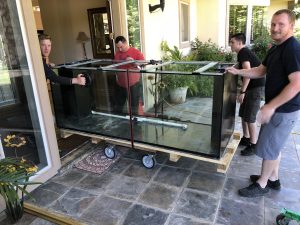
Rolling it out of the house.
You want to be careful coming down a doorway’s threshold, onto the walkway. Don’t let the aquarium take any jarring hits. Keep plenty of hands on the tank at this point and move slowly.
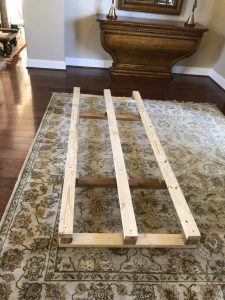
The completed pallet.
We were now faced with getting the aquarium onto the trailer with the least amount of hassle. If we put it on from the back, friction would be hard to overcome as we would need to push it all the way to the front of the trailer. Not only would that be extremely difficult, but the pallet feet would likely buckle under the weight of forcing such a heavy object across planks of rough wood. Zach came up with putting it in from the side. That way, any adjusting of the aquarium would happen in the direction of the pallet feet and would be much easier. Hire good people and you get good results. Curtis, Zach and I have moved many large tanks together over the years and though I provide the opportunity, they make me look good!
Putting the tank strapped to the pallet onto the trailer from the side was genius and worked very well. That was it for the day after strapping it all down to the trailer. Alex and I would be transporting it to the manufacturer about 3 hours away in just a couple of days. Everyone was safe and not a single scratch on the client’s home. It’s like we knew what we were doing or something.
I hope this has proven worth your time to read and please hit me up with any questions you might have. I would be thrilled to answer them. Take care and be safe!
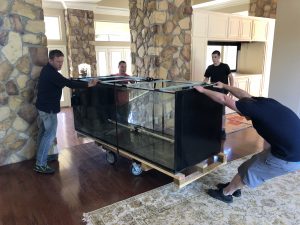
Strapped up and rolling out of the house.
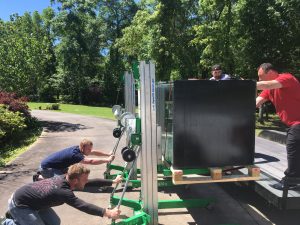
Putting the aquarium onto the trailer from the side.

Recent Comments